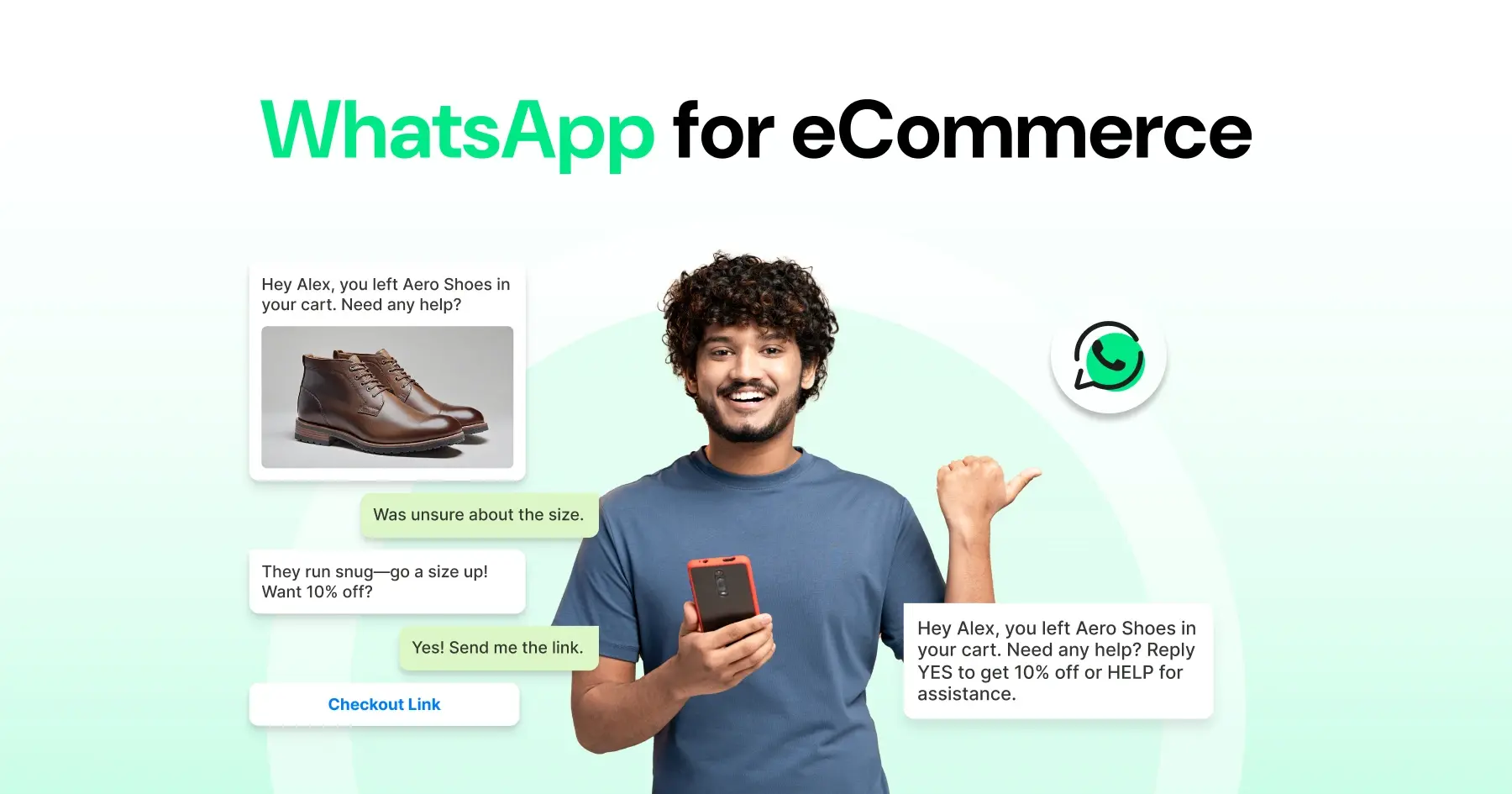
15 Eye-Opening Facts That Reveal Why WhatsApp Drives More E-commerce Sales
Written by:
 Rohan
|
on:
November 18, 2025
|
Fact Checked by :
Rohan
|
on:
November 18, 2025
|
Fact Checked by :
 Namitha
|
According to: Editorial Policies
Namitha
|
According to: Editorial Policies
Too Long? Read This First
- WhatsApp for e-commerce is changing how online stores sell and connect with customers. It makes shopping faster, easier, and more personal.
- Customers now expect quick, real conversations instead of waiting for emails or web forms. WhatsApp helps brands meet them where they already are.
- It supports everything from product discovery and order updates to returns and customer care.
- The WhatsApp Business App works well for small sellers, while the WhatsApp API for e-commerce helps larger brands automate and scale.
- A WhatsApp chatbot for e-commerce can answer questions, recover carts, and send timely updates around the clock.
- With Wati, businesses can bring all of this together in one place and build relationships that feel personal and effortless.
You know what’s funny? Most e-commerce stores spend thousands on ads just to get customers back to an app they already use every day.
The average person checks WhatsApp over 20 times a day. It’s where people ask for size guides, share product screenshots, and confirm delivery updates.
In other words, your customers are already shopping in conversation.
They just aren’t doing it with you yet.
That’s where WhatsApp for e-commerce changes everything. With WhatsApp for Business, you can chat, convert, and support in one trusted space that your customers already open.
In this blog, you’ll learn why WhatsApp for e-commerce is becoming a must-have for online stores, how it helps you sell smarter, and what you can do to make the most of it.
What is WhatsApp for E-commerce?
WhatsApp for e-commerce means using WhatsApp as a marketing, sales, and support channel for your online store.
It’s using WhatsApp to chat, share products, answer questions, and guide customers through their buying journey.
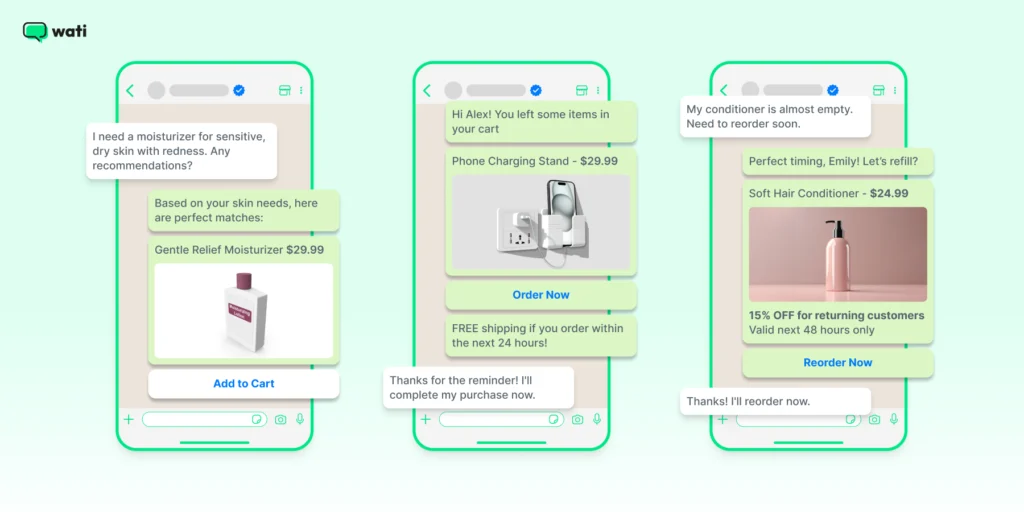
Think of it as bringing your store right into your customer’s chat list.
You can send product recommendations, confirm orders, share updates, or help someone decide what to buy in one conversation.
Do You Really Need WhatsApp for Your E-commerce Store?
Yes!
If you are still wondering whether WhatsApp is worth adding to your e-commerce setup, the short answer is an absolute yes. Here’s why.
Your customers already spend a big part of their day on WhatsApp. Each day, over 140 billion messages fly across WhatsApp.
People use it to chat, share photos, track deliveries, and even talk to brands they trust. More than 175 million people reach out to businesses on WhatsApp every single day.
Inside WhatsApp E-commerce: How It All Comes Together
When shoppers buy from you via WhatsApp, it’s less about a transaction and more about a conversation that leads to a purchase.
You meet them where they already hang out, and you guide them from discovering your product to hitting buy, and then through delivery updates and support.
There are two main tools here: the WhatsApp Business App and the WhatsApp Business API.
- The Business App is perfect for very small stores. You create a profile, set up a catalog, reply to customers manually, and handle chats directly from your phone.
- The Business API is made for scale. You integrate WhatsApp Business API into your workflow, create an online store, and integrate with CRM if you are already using it. You can run campaigns, send bulk messages, and view analytics right in front of you in your WhatsApp Business API dashboard. That lets you automatically send order confirmations, delivery notifications, and reminders.
As WhatsApp messages have click-through rates of over 50%, you’re not just reaching people, you’re actually getting them to act.
Here’s a simple flow to picture how it works 👇
– A customer sees a product link you shared in WhatsApp.
– They click the link, ask a quick question in chat (“Does it come in blue?”).
– You reply, showing a picture of the blue version, the share price, and the delivery time.
– The customer says yes, and you send a payment/link; they complete the purchase.
– You send a shipping update, then follow up after delivery for review or support.
📙Related Read: Enhancing Customer Service for E-Commerce with WhatsApp
How E-commerce Brands Are Using WhatsApp Every Day
Once your store is set up on WhatsApp, the possibilities open up fast.
From sharing product updates to handling post-purchase support, e-commerce brands are using WhatsApp at every step of the journey.
Here are some use cases of WhatsApp for e-commerce.
1. Product Discovery and Recommendations
Shoppers often start with a question.
“Do you have this in my size?” or “What’s new this week?”
Brands use WhatsApp to share curated product collections, lookbooks, or personalized suggestions straight in the chat.
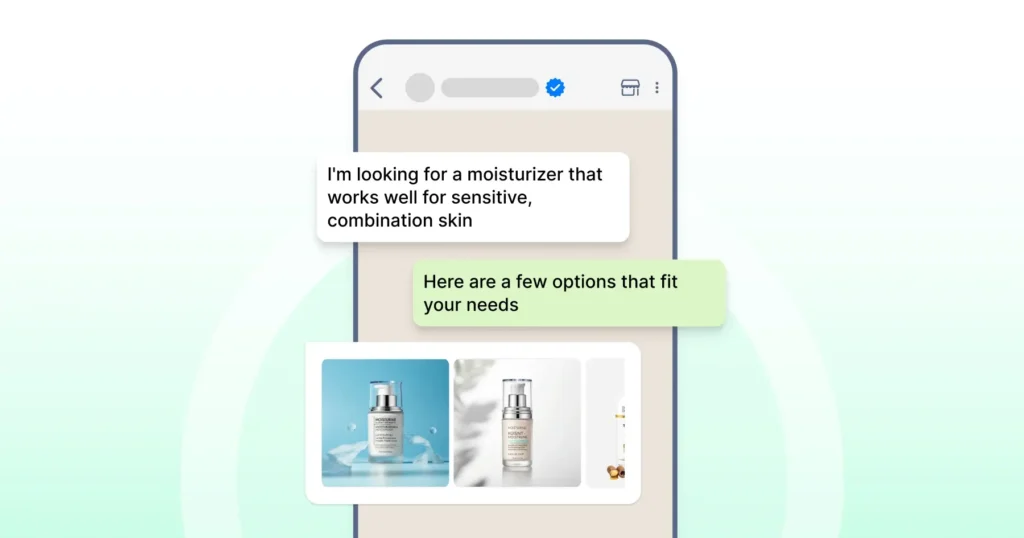
In a way, it’s like a virtual store assistant who always knows what the customer likes.
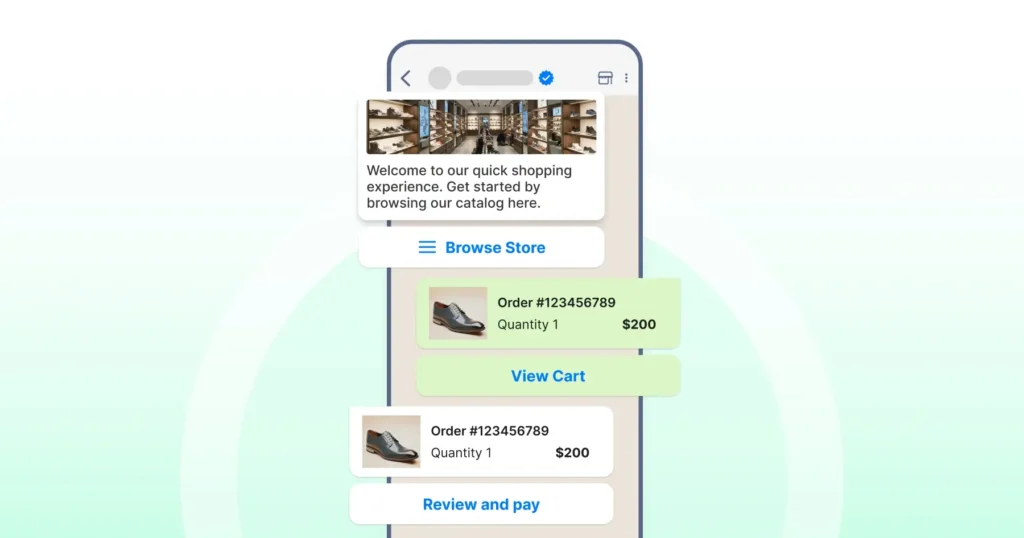
📙Also Read: How to Send a Link in WhatsApp and Get People to Click
2. Abandoned Cart Recovery
Instead of sending another email that never gets opened, brands use WhatsApp to follow up with a friendly reminder.
It is sometimes with a small offer or a quick question to understand why the cart was left behind.
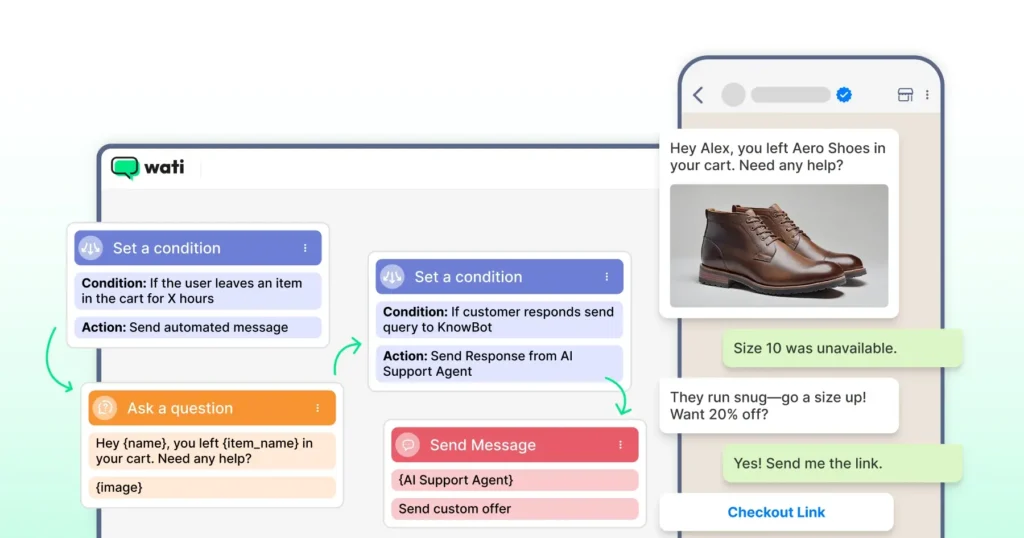
These gentle nudges often turn hesitation into a sale.
Here’s how Bonkers Corner, an Indian streetwear brand, does it 👇
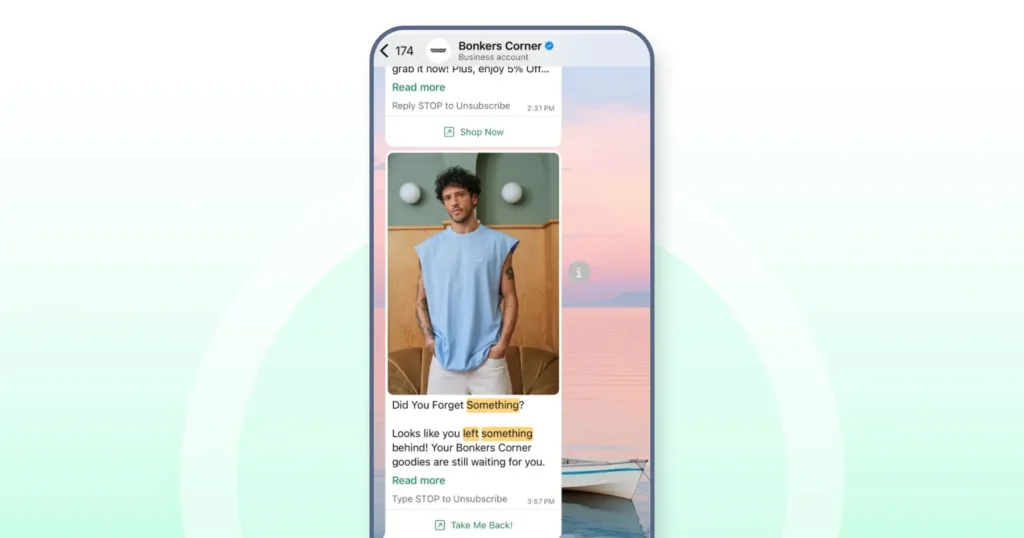
3. Order Confirmations and Delivery Updates
No one likes refreshing tracking pages. With WhatsApp, customers instantly get order confirmations, payment receipts, and delivery updates in one place.
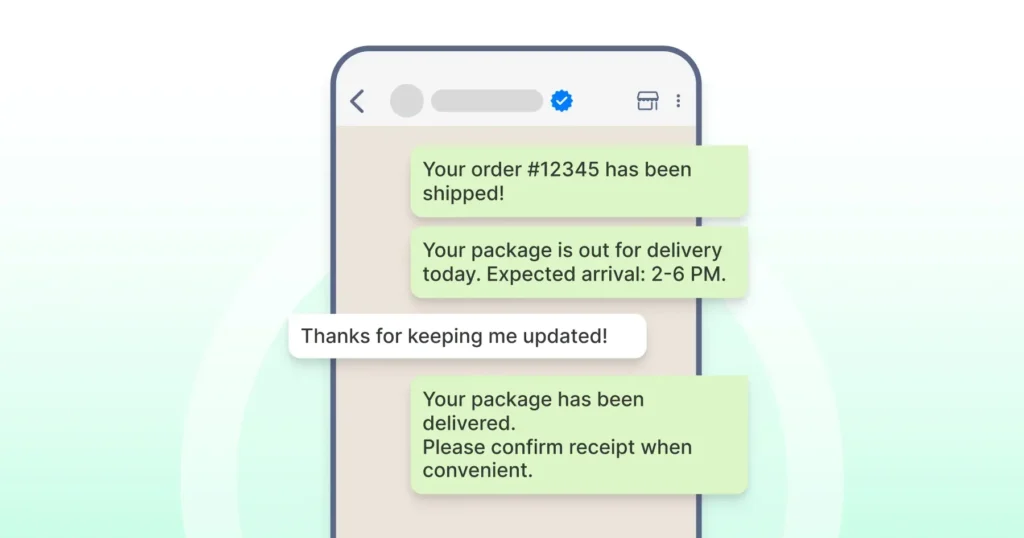
It’s quick, reliable, and keeps the customer loop closed.
4. Customer Support Made Simple
Instead of raising tickets or waiting on hold, customers can message the brand directly.
Whether it’s a product issue or a return request, support feels like a real conversation, not a form submission.

Many brands also use chatbots to handle FAQs before passing complex queries to a live agent.
5. Feedback and Reviews
After a successful delivery, brands can send a quick message asking, “How did you like your order?” or share a one-click link to leave a review.
It’s effortless for customers and helps brands gather authentic feedback at scale.
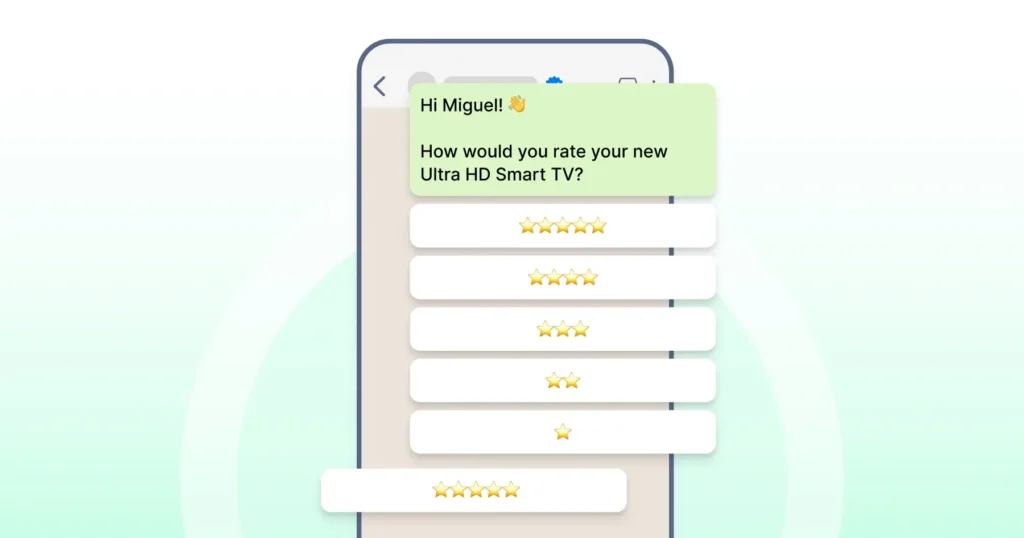
6. Marketing Campaigns and Broadcasts
Using the WhatsApp Business API, e-commerce stores can send personalized broadcasts like:
- Product launches
- Seasonal offers
- Back-in-stock alerts
These are received directly by customers who’ve opted in.

What’s amazing is that these messages don’t feel like spam; they feel like updates from a brand they actually follow.
In short, WhatsApp has become the daily touchpoint between brands and buyers.
It bridges convenience and connection, helping you sell smarter and serve better through simple conversations.
💡Don’t Miss This: How to Create a WhatsApp Broadcast List That Gets Results
7. Lead Capture & Pre-Sales Conversations
Instead of making someone fill out endless forms, brands invite customers into a WhatsApp chat when they click an ad or land on a product page.

That chat becomes a friendly gateway to explore products, ask questions, and even place orders.
Instead of leading potential buyers to a landing page, brands direct them straight into a WhatsApp chat from the click of a WhatsApp ad. This lets customers ask a question instantly, see products, and convert without hopping platforms.
8. Cash-on-Delivery (COD) Verification & Return Reduction
COD orders often come with high return-to-origin (RTO) risk.
Some brands send a WhatsApp transactional message to confirm the order before dispatching.
This simple check helps cut down returns, logistics costs, and improves profitability.
🙌 Don’t Miss This: How to Send OTP on WhatsApp – Complete Setup Guide
9. In-Chat Payments & Seamless Checkout
Brands are letting customers complete purchases directly inside WhatsApp.
With features like native payments or payment links, the entire checkout stays in the chat.
This means fewer steps, lower abandonment, and faster conversions.
10. Re-Ordering & Subscription Triggers
For consumables (think beauty, groceries, pet supplies), brands use WhatsApp to gently remind customers when they’re likely running low.
“Hey, do you need a refill?”
The result: Easier repeat orders and stronger loyalty.
11. WhatsApp as a Personal Sales Assistant
Brands are now using a WhatsApp chatbot for e-commerce to act like a personal shopping guide.
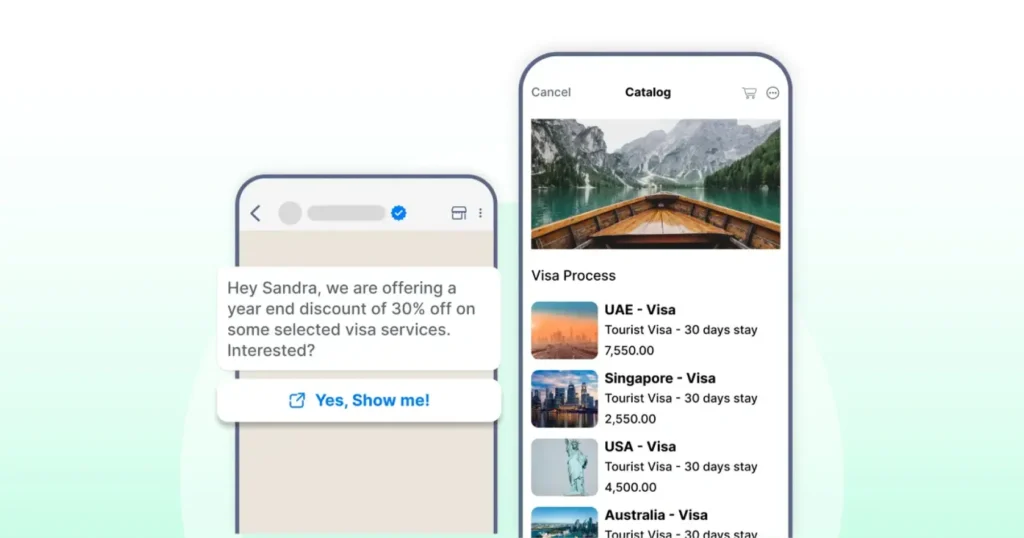
These bots can ask questions (“Looking for sandals or boots today?”), pull in past purchases and recommend items, and even take orders.
With Wati, it’s easy to create these flows and keep your customers engaged without feeling like they’re interacting with an automated system. Wati’s no-code chatbot builder is the easiest way to create a personal sales assistant if you are planning to upgrade to WhatsApp Business API.
12. Creating a Loyalty and Retention Channel
WhatsApp isn’t just for new customers. It’s a strong channel to retain them.
You can send exclusive offers, VIP-only messages, and early restock alerts to your best customers via WhatsApp.
When someone gets promotions directly, discounts in their inbox, it feels much more personalized than seeing a discount advertisement. Over time, this fosters a sense of community and encourages people to return.
13. Personalized Segmentation
Sending the same message to everyone is yesterday’s strategy.
Wati has a segmentation feature, you can send messages to targeted customer groups rather than giving a one short message to all.
You can use your customer data, past orders, interests, and behaviour to create small segments like:
- Summer dress buyers
- Fresh food subs
- Pet owners
You can send these segments tailored messages.

14. WhatsApp as a Multilingual Support Channel
If you serve customers across regions, WhatsApp makes language barriers disappear.
You can offer support in multiple languages, either through multilingual agents or localized chatbots that automatically detect and respond in the customer’s language.
This not only improves satisfaction but also helps brands expand confidently into new markets.
15. Building a Customer Community
Beyond transactions, WhatsApp can bring your customers together.
Many brands create VIP or interest-based WhatsApp groups. For example, a fitness brand might host a wellness group sharing daily tips or challenges.
It’s a space for conversation, where customers feel part of something bigger than a purchase.
Over time, this community builds trust and turns buyers into brand advocates.
| Heritage Foods shifted its customer support and sales process to a WhatsApp-first model using Wati. Customers place or repeat orders, get product updates, and manage subscriptions via chat. The brand reported twice the conversion rate and fivefold better broadcast reach compared to their older SMS/email efforts. Read the full story here. |
Best Practices for Using WhatsApp in E-commerce
Spectrm’s latest report shows that nearly 7 in 10 customers prefer buying from businesses that use WhatsApp for communication.
That says a lot about how today’s shoppers want to interact: quick replies, friendly chats, and real conversations instead of cold emails.
While WhatsApp makes it easier to reach customers, it also raises the bar for how brands should communicate.
Here are a few best practices to help you make the most of WhatsApp for e-commerce.
1. Always Get Opt-Ins Before You Message
Nobody likes surprise messages. Always ask for permission before you start chatting with customers.
You can add a quick opt-in during checkout (“Would you like to get updates on WhatsApp?”) or through a pop-up on your website.
Getting consent builds trust and ensures your messages reach people who actually want to hear from you.
2. Keep It Conversational, Not Corporate
Think of WhatsApp as a place for real talk, not scripted replies.
Use a friendly, human tone: “Hey Rahul, we just restocked your favorite sneakers!” feels far warmer than “Your product is now available.”
A simple emoji 👋 or a casual greeting can make your messages feel like they’re coming from a person, not a bot.
3. Automate Wisely
Automation saves time, but don’t let it sound robotic.
Use WhatsApp chatbots to handle simple tasks, such as tracking updates, FAQs, or store hours.
When a customer needs personal help, make it easy for them to talk to a real person.
For example, “Need help choosing the right size? Tap here to chat with our team.”
4. Use Visuals to Make Exchanges More Engaging
A good picture beats a long text.
So share product images, short videos, or carousel catalogs so customers can browse right inside the chat.
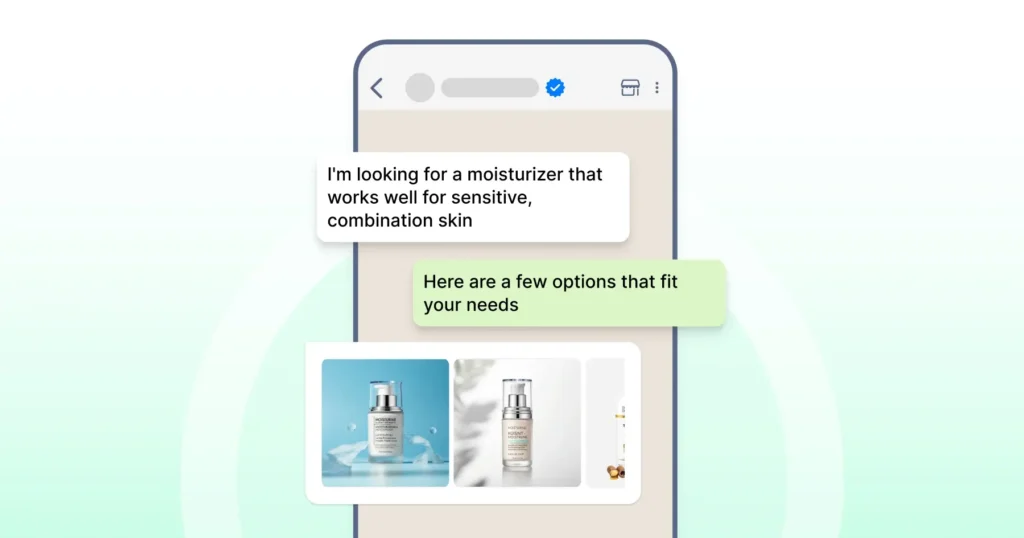
For instance, a skincare brand could send a mini-guide with images showing “Morning Routine vs. Night Routine” using their products.
It’s easy to follow and feels like a friendly recommendation.
5. Personalize Every Message
The magic word here is context.
Base your messages on what your customers actually like or buy.
Example: “Hey Aditi, your last order was our mango body butter. Our new coconut variant just dropped! Want to try it?”
Personal touches like this make customers feel seen, not sold to.
6. Time Your Messages Smartly
Sending a promo at 11 p.m.? Probably not a good idea.
Schedule your messages during local business hours or around shopping peaks: lunch breaks, evenings, or weekends.
This way, your messages land when customers are relaxed and more likely to respond.
7. Measure, Test, and Improve
Keep an eye on your message open rates, replies, and conversion numbers.
If one campaign gets more responses than another, check why. Maybe it’s the timing, tone, or message length.
For instance, “Hey, your cart’s waiting for you 👀” might perform better than “Reminder: You left items in your cart.” Small tweaks make a big difference.
8. Keep It Compliant
Always follow WhatsApp’s Business Messaging Policies, especially around opt-ins, templates, and data privacy.
Think of compliance as part of a good customer experience. It shows you care about transparency and respect your customers’ space.
💡Your Next Read: E-Commerce Customer Experience: How to Scale Up Your Game in 2026
Make WhatsApp for E-commerce Work for You
Juniper Research forecasts that the mobile business messaging market will rise to $78 billion by 2027.
This presents a huge opportunity for e-commerce businesses like yours.
You’ve seen how using WhatsApp for e-commerce can transform every stage of the shopping journey, from discovery to delivery.
Now it’s time to take the next step and turn all those ideas into a strategy you can action.
With Wati, you can bring all of it together. From automated messages and order updates to marketing broadcasts and customer support, everything runs from one simple platform.
You don’t need complex setups or endless tools, but one place to manage every customer interaction.
Start small. Test a few flows, see what clicks, and grow from there.
Book a demo now to see how Wati integrates WhatsApp into your online store.
FAQs
WhatsApp for e-commerce means using WhatsApp to sell, support, and engage with customers. Brands can share products, confirm orders, send updates, and handle support through a familiar chat experience.
The WhatsApp API for e-commerce lets you connect WhatsApp with your store or CRM. It helps you automate messages like order confirmations, abandoned cart reminders, or delivery alerts, making your customer experience faster and smoother.
A WhatsApp chatbot for e-commerce can answer FAQs, suggest products, and help with order tracking 24/7. It saves time, reduces manual workload, and gives customers instant support whenever they need it.
Yes. WhatsApp is one of the most effective channels for e-commerce marketing. You can send personalized broadcasts, back-in-stock alerts, and promotional messages to opted-in customers with high open and engagement rates.
Absolutely. With tools like Wati’s WhatsApp API, you can integrate WhatsApp with platforms like Shopify, WooCommerce, or Magento. This allows you to manage chats, automate messages, and track conversations from one dashboard.
Start by setting up a WhatsApp Business account or connecting your store through a WhatsApp API provider like Wati. From there, you can automate notifications, enable chat support, and start turning conversations into conversions.




Latest Comments